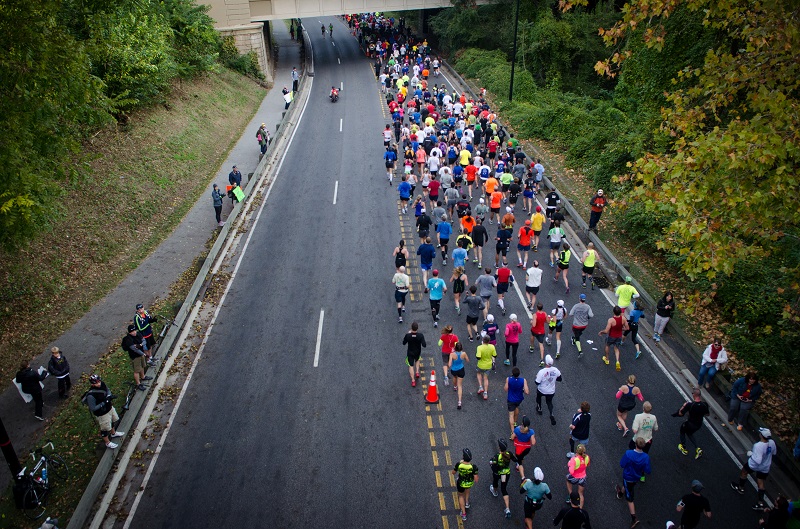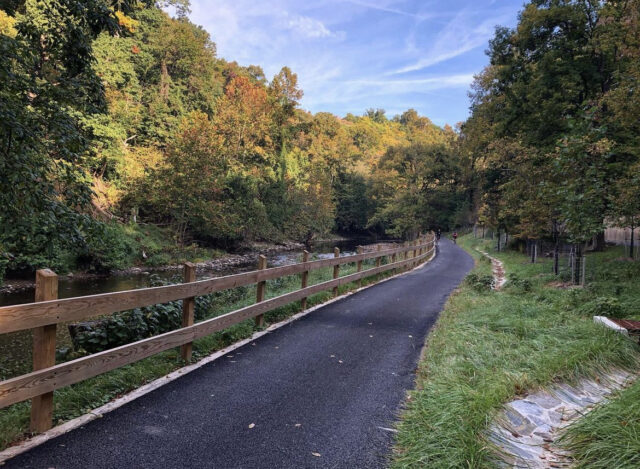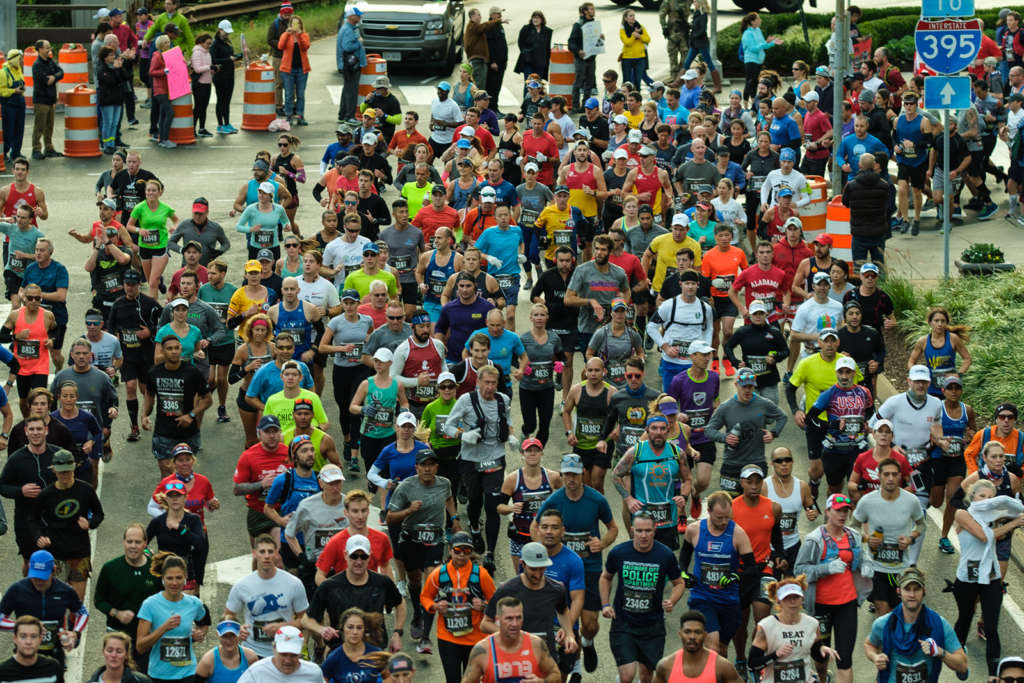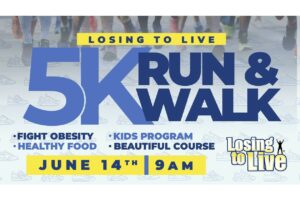Doubts swirled around my head, and my right quad muscles ached with cramp-like pain. It was only ten miles into the 2021 Philadelphia Marathon but as I watched what felt like hundreds of runners zip past me, I started to recalibrate my pre-race goal: Three hours and 50 minutes became four hours. Then four and a half hours. Then simply finishing.
The race turned into a mental battle. My legs screamed for me to stop and walk, while my brain urged me to continue on pace. The 10th mile would be my slowest up to that point. I tried to find motivation wherever I could. I repeated the mantras, “mind over body” and “don’t run scared,” to myself as I locked on to the runners in front of me. I visualized how satisfying it would feel when I crossed the finish line with another sub-four hour marathon. I thought about my supporters back home who were tracking my race online.
Kensington 8K Race
Three distances – 8K, 2M, and 1K – all starting and finishing at Kensington Town Hall.
The 8K runs through historic Kensington, going past Warner Mansion, along Antique Row, beside 120+ year-old houses and around Noyes Library, the oldest library
If I learned anything from the 2023 Parkway Classic, it was that I enjoy pacing people while running and that a large singlet was too big for me and threatened to sag below my shorts when it got wet.
Anyone I work out with on the track knows that I take a lot more pride in running my laps “dead-on-balls accurate” (it’s an industry term) than I do in running any rep particularly fast.
When Elyse Braner asked if I’d like to pace the 7:00 mile runners for 10 miles last April, I found my solution. Most years, the race is a week before my hometown Pittsburgh Half Marathon, and I usually find myself just participating in the Parkway Classic to save my legs for the next seven days. This way I could take part and contribute to someone else’s effort.
I was paired with my pacing partner Sam Wellman and I immediately felt that was unfair to the other runners. We were there to work for them and here I am about to have the time of my life!
I kind of winged it and didn’t read an article I had written 10 years ago on marathon pacing, though I feel like that kind of distance is a whole other animal.
It’s remarkably hard to hold back in a race like the Parkway- the downhill first mile is one thing, but the excitement and great weather makes it so enticing to take what the course gives you. But I owed it to the people who depended on us to get it right, and we came darn close, passing the mile in 6:56.
I’ll spoil the ending right now and say we didn’t run any 7:00 miles- we were generally four or five seconds faster. Former RunWashington writer and experienced pacer Vanessa Junkin said it’s okay to be a little fast, but for someone who likes to hit his track laps consistently and excoriates himself when he’s off by half a second, I worry I might prompt someone to overextend themself keeping up with me.
I was able to assuage that when I loosened up and Sam and I started chatting with the runners and between ourselves. We joked about what kind of “that dawg” we have in us. I think about it a little further – in Ghostbusters, did that demon dog say “I got that Louis Tully in me?”
Sam has no idea what I’m talking about. He hasn’t seen Ghostbusters. Youth is wasted on the young.
The great thing about the race is that no matter how it goes, you have great views all throughout the race, and the groups of neighbors who come out to cheer every year makes it memorable.
I’ve loved the Parkway Classic for years. I set a PR running alone in a steady rain in 2012 and regardless of my time, I thought the experience was beautiful. In 2017 I found myself way out in front and shouted requests to my publisher, Kathy Dalby, ahead of me in the pace car. She obliged with Casey Jones and Gumbo, the latter not exactly what I anticipated for Phish but I wasn’t going to argue. Hell, long before I’d moved here, I knew about the race because my college track coach, Steve Taylor, won it back when it was a 15k. What I didn’t k ow back then was how he dressed for the race.
As we battled the toughest stretch of the course by my estimation- the climb to the end of mile nine, I saw the group that clustered around us start to take off and use what they had left. They were going to make their goal, and they were waiting in the finishing festival to celebrate that.
I’ll get a chance to pace again at the GW Parkway, April 28, when I take the 6:00 runners down the road. Come on out and join me!
Sam Doud was itching to run, just for a few shakeout miles.
The problem was that he was at a post-race party after the California International Marathon (CIM) in Sacramento, Cali., where everyone else was happy to put the last 26.2 miles behind them. On that December 2018 morning, he was 52 seconds too slow to qualify for the 2020 Olympic Marathon Trials, and eager to fix that. But he took a few steps and realized a run just wasn’t going to happen.
The next few years were a mix of overtraining, a pandemic and three failed attempts, but when he came back to Sacramento in 2022, he had his time. Running 2:15:52 brought him comfortably under the men’s qualifying standard of 2:18, making him one of three D.C. area runners to qualify for the 2024 Olympic Marathon Trials that morning, all members of the Georgetown Running Club (GRC). The men’s race starts at 10:10 a.m. and the women’s race starts at 10:20 a.m.. It will be broadcast live on Peacock and at noon on a tape delay on NBC. Franklin Hall — 1348 Florida Ave. NW — will play host to a viewing party with doors opening at 9:30 a.m. and a run starting at 8:30 a.m.
In the next year, GRC would add five more qualifiers and all eight will represent the D.C. area at the Olympic Marathon Trials Saturday in Orlando. Susanna Sullivan also qualified for the Trials, running well under the women’s 2:37 marathon standard, but announced her withdrawal Wednesday after a positive COVID test.
Doud, who lives in D.C. was the first to join the club, a year after he made his marathoning debut back when the Rock ‘n’ Roll D.C. races included 26.2 miles, when he won in 2:26:57.
“That’s when I started thinking about what I could do on a faster course, with more people and I’m not wearing head-to-toe spandex.”
Despite Doud’s travails en route to his OTQ, GRC Coach Jerry Alexander said he hasn’t been far off.
“He’s been in great shape, the timing just hasn’t been right,” Alexander said. “It was never a lack of fitness.”
With his qualification out of the way, Doud has spent the lasy year racing shorter distances and planning a fall wedding to a fellow marathoner, Emma.
Doud followed Fairfax County’s Tom Slattery (2:15:34) and D.C.’s Zach Herriott (2:15:42) to the finish line at CIM.
Slattery and Herriott had made one attempt together that spring at the Glass City Marathon in Toledo, Ohio, where hot and humid conditions humbled the pair, sending Herriott to the medical tent.
“I vividly remember finishing and telling my friend that I was never running another marathon again,” Herriott said.
Herriott had taken a few years off of running after a record-setting career at the University of Virginia. The pandemic prompted him to start training again — and to win the virtual Credit Union Cherry Blossom Ten Mile — and upon joining GRC, he found support for a return to competitive racing. And the marathon seemed like the right goal at that time of his life.
“I was getting close to 30 and didn’t think I would be racing college kids on the track again,” he said. “After a few months of consistently running and occasionally doing workouts, I started to enjoy the rhythm of training again.”
While he felt ready to race the marathon again at CIM in December 2022, he first raised money for Fred’s Team at Memorial Sloan Kettering Cancer Center and ran at the New York City Marathon a month earlier.
“The timing was really close to CIM, but I felt like it was a good way to bleach the memories of Glass City out of my head,” he said. “I think I would have qualified either way, but I really think doing that was really big for my confidence because it made me not afraid of the distance.”
CIM was Slattery’s second time qualifying for an Olympic Trials. He previously qualified for the 2020 Trials at the 2020 Houston Marathon running 2:18:35, after just missing the qualifying standard by nine seconds six weeks prior at CIM. Running his third marathon in as many months he finished 152nd at the 2020 Trials in 2:32:21.
Slattery hoped to avoid a similarly dense racing schedule this go round by qualifying a year in advance. Securing his qualifier in 2022 allowed him to ease up over the first half of 2023 before racing in the elite field for the New York City Marathon in the fall, fulfilling a lifelong dream.
With a newborn daughter, Slattery plans to ease back even more from running after the Trials.
“This is the top of the mountain for me,” he said. “I just want to enjoy the experience of running with the guys I qualified with and look at the race as a celebration of all the coaches who invested in me to help me get here.”
Those coaches include Kevin Beirne and Bill Carriero from Slattery’s Long Island alma mater Chaminade High School, Tom Dewey and Brian Horowitz from Fordham University and Alexander.
“Tom doesn’t need coaching, he just needs a pat on the back,” Alexander said. “With all he has going on, he’s remarkably good at compartmentalizing and focusing on running when it’s time to run and everything else when it’s not.”
Elena Hayday, the only local woman racing the Trials, had the distinction of being one of the few nationwide to meet the 1:12 half marathon standard, running 1:11:33 at the 2023 Houston Half Marathon.
Despite leaving the cross country and track teams at the University of Minnesota, Hayday kept training and discovered, after beating her 5k PR by almost a minute at a low-key track meet, that she had more left to do with competitive running.
“Whatever I was doing in college, I was not running at my potential and it kind of just lit a fire to figure out what my potential actually is,” she said.
She followed that up with a 2:30:51 at Grandma’s Marathon in Duluth, Minn., her first serious effort at the marathon, but one that came without the pressure of qualifying.
“I was a little afraid of the distance,” she said. “I got started with some women who were running a little faster than I should be, so there was a point where I felt like I shouldn’t be hurting that much at mile 13 if I have to run 26, but after I dropped back for a while I finished pretty strong.”
The last few months have seen Hayday, of D.C., focus more on marathon-oriented mileage and longer workouts.
“I feel like I’ll be much more confident in making a move a little bit earlier even if it hurts a little bit more and actually being able to hold on to that pace,” she said.
Alexander said though the marathon distance is relatively new to Hayday, her preparation should make up for her inexperience.
“She has no reason to be nervous going in,” he said. “People who haven’t done the work should be nervous. She’s not one of them.”
Arlington’s Clint McKelvey edged Doud in moving to the D.C. area nearly 10 years ago. Running primarily with Dustin Sweeney’s old Pacers team in the middle of the 2010s, he stuck to the traditional post-collegiate 5ks and 10ks until looking toward the marathon at the end of the decade.
“If you’re at a certain competitiveness level where you’re running post collegiately but you’re not going to go pro, making the Olympic Trials is kind of the biggest milestone people work towards”
McKelvey took swings at Grandma’s Marathon and the California International Marathon in 2019, finishing about a minute and a half off the qualifying standard at the latter. He took the opportunities provided by remote work during the pandemic to run more, including training at altitude in Park City, Utah, and came into early 2021 as ready as he had been to race fast, except there were few races and the qualifying window for 2024 had not yet opened.
He tried to come back from a metatarsal stress fracture and put himself back a few months in 2022, but he found good time for a Trials attempt at the Eugene, Ore. Marathon in spring 2023 where he ran 2:16:35.
McKelvey felt a bit of a motivational lull during the D.C. summer, but eventually saw a positive trend in his training.
“Before Eugene I felt better on my shorter workouts, but in this cycle I feel better on my longer workouts,” he said. “Given that I’m racing a marathon, that’s going to be a good thing.”
He’s been training in Central Florida since Jan. 1, adjusting to warmer and more humid conditions and flatter routes.
“His problem over the years has been staying healthy,” Alexander said. “Once he figured out what training he could tolerate safely, his tactical sense really put him ahead of a lot of runners.”
Owen Ritz ran his first, and only, marathon on a whim after finishing graduate school at Georgetown. The Philadelphia native raced his hometown marathon in 2022 at the urging of his former Dartmouth teammates that summer.
“I was starting to train more and more like a long distance runner at Georgetown,” he said. “I was running 90-100 miles a week my fifth year and my teammates said I should race a marathon.”
After starting the first 10k was a group of runners pushing a 2:12 pace, he relented, figuring that would be unsustainable. To his surprise, there was no chase pack to latch onto, so we went alone.
“You think about every situation that can happen in a big race, but it’s pretty rare that you end up being on your own for 20 miles,” he said. “I just stayed calm and pretended I was on a long run.”
He finished in 2:17:46, securing his Trials qualifier, and looks forward to a little more company in his next marathon.
D.C.’s Zack Holden is one of the few “Division IV” runners in the field — collegiate club runners.
“I feel a little imposter syndrome, but I’m getting used to competing with people who have been a lot faster than me and who come from more resources,” he said.
While running for Virginia’s club team in 2019, he tacked on the Philadelphia Marathon to the end of his season. Running his first marathon brought him an epiphany that may be familiar to others: he went from amazement that people complain about marathons in the early miles to understanding why once he hit mile 20.
Holden grew up in Vienna, Va., where he ran for James Madison High School and scored as a junior for a Warhawks team that upset two-time defending 6A champion Lake Braddock in the 2016 state championships.
After joining GRC in 2022, he spent the first half of 2023 refining his shorter distances — a 14:26 5k, a 29:57 10k — before running 48:53 at the Broad Street 10 Mile in May that demonstrated he was ready to make an attempt at the standard at the Indianapolis Monumental Marathon in the fall.
“Broad Street was probably the moment when I felt like it wasn’t just a possibility,” Holden said. “But I would not be here without having guys like Zach Herriott, Sam and Slattery. When I joined the team I looked up to them and now I’m able to train with them.”
Holden’s instincts were right. He felt good with 5k to go in Indianapolis and closed smoothly for a finishing time of 2:16:54 and a trip to the Trials.
As the announcer in Indianapolis celebrated Holden’s finish, John McGowan was falling apart. The last five miles passed in slow motion, as he saw his pacing deteriorate and finished 38 seconds short of an OTQ. Excitement for his teammate Holden anesthetized him somewhat and he turned his hopes to the California International Marathon in December.. Fortunately, McGowan was aided by a scheduling quirk that put Indianapolis a week earlier than usual, offering an extra seven days of recovery before his next attempt.
“I felt like I had the fitness but just couldn’t quite make my legs move the way I wanted to [in Indianapolis],” he said. “I finished the race pretty gassed but also feeling like I had a little bit more to give.”
McGowan had recently returned to D.C., where he had grown up as a runner–and Foot Locker finalist — for Sidwell Friends School, and attended law school. He had a three month gap between ending his clerkship in New Haven, Conn. — where he had also run for Yale — and his start at a law firm.
Approaching 30, fatherhood and a more rigorous professional life, he aimed to run a fast marathon. A win at the 2023 Providence Marathon in Rhode Island told him he was on track, and upon moving home, he started training with GRC. He lived like a pro–making lunches for his wife, napping, doubling and making the most of his sabbatical. That included a win at the D.C. Half Marathon in September.
When he got to California, he did what he couldn’t in Indiana — run 2:17:28. His reward, besides a trip to Orlando? He had to start work the next morning back in D.C.
“I’ve had to get all the more efficient with the way I use my time now, but I’m enjoying some of the professional challenges that I have now,” he said. “It’s just some more balls in the air, so I have to be more efficient—no more doubling, I’m running 80 or 90 miles a week instead of 120.”
Five runners who grew up around the D.C. area but continued racing will be competing on Saturday.
Keira Carlstrom D’Amato, who ran at Oakton High School and American University and now lives in Richmond, comes into the race as the second fastest American marathoner (her 2:19:12 at the 2022 Houston Marathon was an American record) and half marathoner (her 1:06:37 was an American record). She’s ranked second only to Emily Sisson, who now holds the American marathon record in 2:18:29. She finished 15th at the 2020 Trials, and has since made World Championships teams in the marathon in 2022, where she finished eighth, and 2023.
Johnny Phillips, a Thomas Jefferson alumnus who lives in Boston, ran 2:14:11 at the 2022 Grandma’s Marathon, and is the fastest marathoner with local ties. He was 40th in 2020.
Poolesville alumnus Chase Weaverling, who now lives in Boulder, following a 2:15:48 at Grandma’s in 2023, is heading to his second Trials.
Alex Taylor, a Woodbridge alumnus living in Boston, will be one of the oldest men in the field at age at his second Trials. He ran 2:17:32 at Grandma’s Marathon in 2023.
Ellicott City, Md. native Brian Harvey, who lives in Boston, ran 2:17:40 at Grandma’s Marathon in 2022 to qualify for his third Trials.
Two qualifiers with local connections will not be racing.
Susanna Sullivan, who ran at George Mason (now Meridian) high school and lives in Reston, saw a career resurgence starting in 2020 after working with George Mason University coach Andrew Gerard. She ran 2:24:27 at the 2023 London Marathon, ran the 2023 World Championships Marathon and won the 2022 Credit Union Cherry Blossom Ten Mile, but will miss the Trials after testing positive for COVID.
Katy Kunc Presley, a Lake Braddock alumna living in Lexington, Ky. qualified with a 2:33:31 at the 2022 California International Marathon but suffered a torn labrum in her hip and will not race.
Zebra Dazzle 5k Walk/Run or 100 Bike over 30 Days
Join the Zebras for this Zebra Dazzle event for all fitness levels. The 5k Walk/Run has 2 options. You can participate as an onsite participant on 9/13 at Carter Barron in Rock Creek Park, NW Washington DC or as a
- St. Albans alumnus Tai Dinger won the USATF Club Cross Country Championships in Leon County, Fla. (Photo by Mike Scott)
- Northwood alumnus Andy Carr was named the Road Running Technical Committee Ted Corbitt Award winner by USATF.
- Montgomery Parks’ Capital Crescent Trail survey closes Jan. 2.
- Three local runners played a role in NCAA Division I Cross Country titles in November in Albemarle County, Va.
- Good Counsel alumna Leah Stephens, a freshman at N.C. State, finished hundredths of a second ahead of two runners to give the Wolfpack a one-point win over Georgetown alumnus and former coach Mike Smith’s Northern Arizona team.
- Alex Gibby, a Langley alumnus, coached Harvard’s Graham Banks to the men’s title.
- Will Palmer, a Walt Whitman alumnus and former Georgetown assistant, coached Florida’s Parker Valby to the women’s title.
- D.C.’s John McGowan, a Sidwell Friends alumnus, qualified for the U.S. Olympic Marathon Trials after running 2:17:28 at the California International Marathon.
- Prince William County, Va.’s Board of Supervisors voted to spend $310,00 for a feasibility study for an indoor track facility, and a $550,000 for deposit on a 21.8-acre site along Telegraph Road in Woodbridge. The Prince William Times reported that if the supervisors decide to move forward with facility after the feasibility study is completed, the county will pay $16 million for the property.
- Comments are open until Jan. 2 for Montgomery Parks’ Capital Crescent Trail 2.0 Facility Plan.
Losing to Live 5K Run & Walk
WHEN Saturday, June 14, 2025 at 9:00 am WHERE This convenient location is just minutes from your house located 1/2 mile inside the 1-495 Capital Beltway at exit 51. Spectators are welcome to watch and cheer on the runners. Capital

This article originally appeared in the January/February 2014 issue of RunWashington.
Runners run, elected officials legislate and besides the dozens of honorary congressional chairs for the Cherry Blossom Ten Mile, never the twain shall meet.
Until October 2013. The first federal government shutdown in 17 years threw the running community into uncertainty as runners were ostensibly banned from National Park Service property and race permits for that land disintegrated, putting the region’s marquee race in doubt.

The “zoo loop” in Rock Creek Park now closes at 5 p.m.
Comments are due Sept. 28 on the Arlington Boulevard Trail project.
Heritage alumna Weini Kelati will represent the United States in the 5k at the World Road Racing Championships Oct. 1 in Latvia.
In 2024, the Army Ten-Miler and Marine Corps Marathon will be part of the Armed Forces Series Challenge, along with the Air Force Marathon, the Coast Guard Marathon and the Space Force T-Minus 10 Miler. The challenge involves finishing all five races.
News4 reported that a woman detained a man on an electric bike who she says groped her while she was jogging in Arlington.





